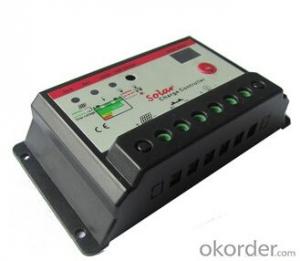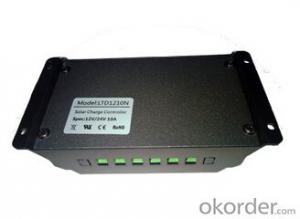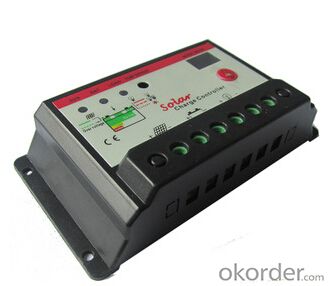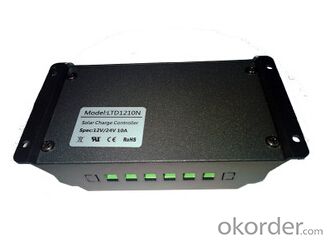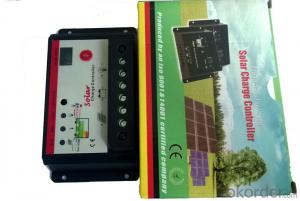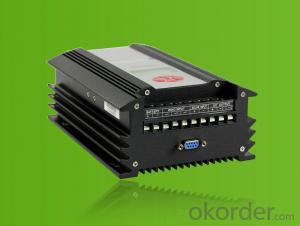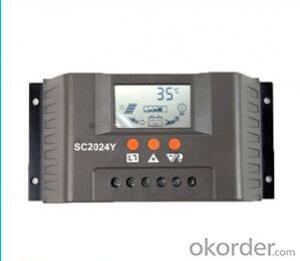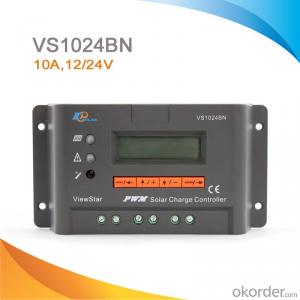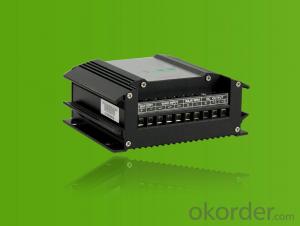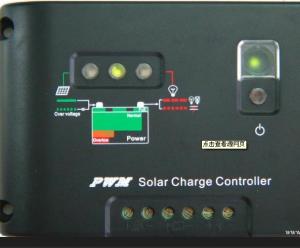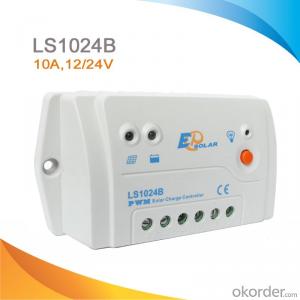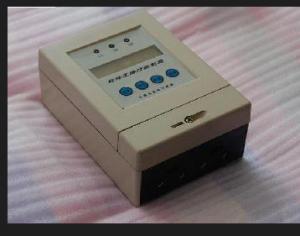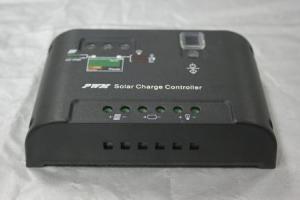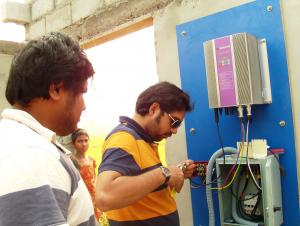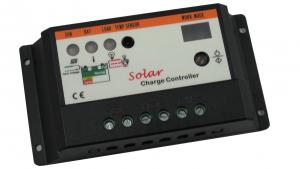Victron Solar Charge Controllers Bygd SC2024S for Streetlight System
- Loading Port:
- Shanghai
- Payment Terms:
- TT OR LC
- Min Order Qty:
- 10 unit
- Supply Capability:
- 50 unit/month
OKorder Service Pledge
OKorder Financial Service
You Might Also Like
Details of products:
product model: SC2024S 20A
External Size:133mm×70mm
Mounting hole Size:126mm×50mm
Performance
12V/24V automatical adaption, control and set button changed into tact key, larger contact terminal can offer wire of 6 m2
◆ double LED digital display, clear for observation
◆ recharging mode by three phases
◆ PWM pulse modulated recharging technology
◆set light-dependent control and 1-13hous time control
◆short circuit protection, overvoltage protection, overcurrent protection and lighting protection
◆standy current no more than 5mA
example
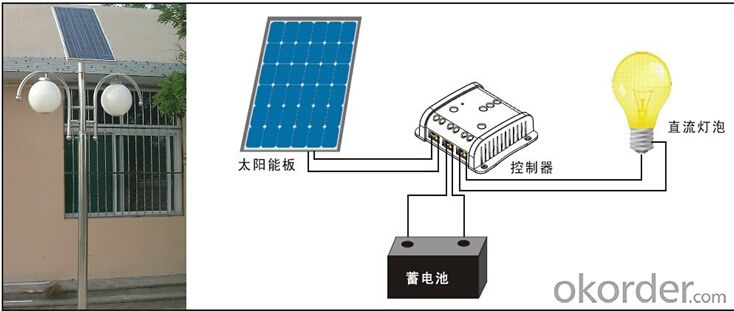
Technical characteristics
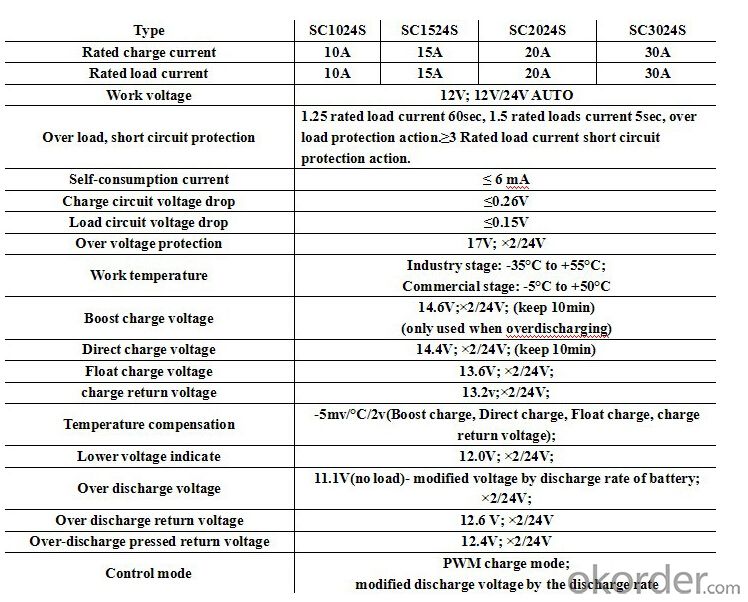
P.S.: This product is manufactured by order, so please call us for more info and service
- Q: What is the purpose of the battery deep discharge protection feature on a solar controller?
- The purpose of the battery deep discharge protection feature on a solar controller is to prevent the battery from being discharged below a safe level. This feature helps to prolong the battery's lifespan and prevent damage to the battery cells. It also ensures that there is always enough charge remaining in the battery to power the connected devices or appliances.
- Q: How do I protect a solar controller from lightning strikes?
- To protect a solar controller from lightning strikes, it is recommended to install a surge protector or lightning arrestor between the solar panels and the controller. This device will divert excess electrical energy caused by a lightning strike away from the controller, reducing the risk of damage. Additionally, ensuring proper grounding of the entire solar system can further minimize the chances of lightning-related issues.
- Q: How the solar panels with the controller
- Solar controller mode: 1, pure light control mode: when there is no sunlight, the light intensity dropped to the starting point, the controller delay 10 minutes to confirm the start signal, according to set the parameters to open the load, the load began to work; when there is sunlight , The light intensity rises to the starting point, the controller delay 10 minutes to confirm the closure of the signal after the closure of the output, the load to stop working.
- Q: How does a solar controller handle short-circuit conditions?
- A solar controller typically handles short-circuit conditions by detecting the excessive flow of current and immediately shutting off the circuit to prevent damage to the system.
- Q: Can a solar controller be used in extreme weather conditions (high winds, heavy rain, etc.)?
- Yes, a solar controller can typically be used in extreme weather conditions including high winds and heavy rain. Most solar controllers are designed to be weather-resistant and can withstand these conditions without any issues. However, it is always recommended to check the specific manufacturer's guidelines and specifications to ensure the controller is suitable for the intended weather conditions.
- Q: Can a solar controller be used with a grid-tied solar system?
- No, a solar controller cannot be used with a grid-tied solar system.
- Q: How does a solar controller handle battery state of charge monitoring?
- A solar controller handles battery state of charge monitoring by continuously measuring the voltage and current flowing into and out of the battery. It monitors the battery voltage to determine its state of charge and uses this information to regulate the charging process. Additionally, some advanced solar controllers also incorporate temperature compensation and algorithms to optimize the charging profile and extend battery life.
- Q: How does a solar controller handle voltage drops in the system?
- A solar controller handles voltage drops in the system by regulating the flow of current from the solar panels to the battery bank. It ensures that the voltage level remains stable and adjusts the charging parameters accordingly to prevent overcharging or undercharging of the batteries. Additionally, some advanced solar controllers may include a feature called Maximum Power Point Tracking (MPPT) that optimizes the solar panel output by converting excess voltage into additional current, compensating for any voltage drops in the system.
- Q: Can a solar controller be used with solar-powered remote monitoring systems?
- Yes, a solar controller can be used with solar-powered remote monitoring systems. A solar controller is designed to regulate the charging and discharging of batteries in a solar power system. It ensures that the batteries are charged efficiently and protects them from overcharging or discharging. Therefore, it can effectively control the solar power supply to remote monitoring systems, ensuring reliable and continuous operation.
- Q: Can a solar controller be used with solar panels that are not facing directly towards the sun?
- Yes, a solar controller can be used with solar panels that are not facing directly towards the sun. Solar controllers regulate the flow of electricity between the solar panels and the battery, ensuring efficient charging. While solar panels perform best when facing directly towards the sun, they can still generate some electricity even when not perfectly aligned. The solar controller helps optimize the charging process, ensuring that the available sunlight is maximized and the batteries are charged as efficiently as possible.
Send your message to us
Victron Solar Charge Controllers Bygd SC2024S for Streetlight System
- Loading Port:
- Shanghai
- Payment Terms:
- TT OR LC
- Min Order Qty:
- 10 unit
- Supply Capability:
- 50 unit/month
OKorder Service Pledge
OKorder Financial Service
Similar products
Hot products
Hot Searches
Related keywords
